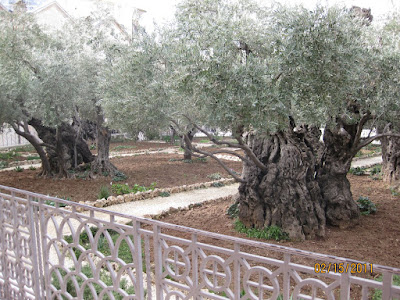Here we are descending the Mount of Olives towards Jerusalem.
On the side of the Mount of Olives are acres and acres of Jewish cemetery sites; at the bottom of this hill is the burial site of Absalom, David's son.
Garden of Gethsemane
Towards the bottom of the Mount of Olives is the claimed location for the Garden of Gethsemane from the time of Christ. Gethsemane literally means “oil press”, and since back in those days olive trees (and therefore olive presses) were everywhere, no one can really be sure exactly where Jesus prayed to the Father before his crucifixion. It is still a very special site to visit, and has 2,000 year old olive trees as well as a very ornate Catholic church.
A few of the amazing 2,000 year old olive trees, still producing olives today!
We like this carving because it depicts Jesus praying passionately to the Father before His crucifixion, as told in Matthew 26. He knew the weight of the sin of all believers would soon be on him, as well as separation from God the Father for the first time since eternity past, and it is unimaginable for us to understand what must have been going on in His mind. He was in so much agony over this, that His sweat became like great drops of blood while He prayed.
Here's a view of the front of the church at the Garden.
Old City Jerusalem
We started our 4 mile trek into the Old City of Jerusalem, through the Mt. Zion gate, and saw many beautiful buildings like this one. We learned that it's a law for all buildings to be built with Jerusalem Stone, in order to preserve the continuity and appeal of the city.
This building is “traditionally” said to be built on the location of the last supper; no one knows where exactly it happened, but the location was passed down from the generations.
Unfortunately the tomb itself was under construction, but it was exciting to be near the site where the man after God's own heart was buried.
A street in the Jewish quarter of Jerusalem.
Old City Market
Here is an underground Jewish market in Jerusalem. When rebuilding Jerusalem in 1967, sites like these shops were discovered and preserved permanently (the modern homes and buildings were built on top). These shops were from the time of the Crusaders!
This was in one of the shops – Philadelphia Phillies in Hebrew! :)
Adjacent to the Jewish market was the Arab market – a much different style and feel. In the Jewish market the price was already marked on the items (like in America), but in the Arab market there were no prices - they look at you and make one up. Then the haggling begins.
Also in the Arab market – butcher shops with piles of questionable meat.
We saw a guy selling belts a few stands back; one of these butchers needs to invest in one.
Even 7000 miles away from home Steve got to enjoy a good 'ole hamburger!
Temple Mount
Here is the South Eastern corner of the Temple Mount in Jerusalem – the original Temple Mount built by King Herod was mostly knocked down by the Romans. The walls were later rebuilt by conquerors.
Towards the bottom of the wall, you could still see the original stones from when it was built by King Herod. Quite large.
Here we are sitting on the Southern steps of the temple mount – the very place Christ would have been teaching outside the temple! The first few steps are the original stone, and the rest were rebuilt later.
On a side note, as you can see Steve's outfit for the day included a Phillies hat and Penn State sweatshirt. This was an unexpected icebreaker for random American Pennsylvanians to smile and introduce themselves throughout the day in Jerusalem. Who would have thought so many neighbors were visiting? Made us feel close to home.
Western (Wailing) Wall
Next we walked around to see the Western Wall, which is considered by Jews to be the holiest site in Israel (since the temple was destroyed). It is so sacred because it is the largest section and last remnant of the original wall built by King Herod. It is often referred to as the “Wailing Wall” because for centuries the Jews have come here to mourn the loss of their temple and to pray.
Men (mostly Jewish) offering up their prayers at the Western Wall.
People believe the wall grants special access to God, and thus write out prayers and stuff them in the cracks of the wall.
Only part of the Western Wall could be excavated. The rest of the wall is still buried, and since Arabs built communities on top of the rest of the remains, a tunnel was built by the Israelis to allow people to go underground and view the lower section of the wall built by King Herod. Hope you're not claustrophobic!






















1 comment:
Finally getting around to leaving a comment. I really, really enjoyed your blog. And it was great travelling with you guys. you can reach me at eludinternational yahoo com. I'm borrowing a few of your pictures for my video presentation. hope that's ok. you guys have some great shots. And I have at least a dozen of that "blue jacket" Blessings! Love (3rd grandson) Eric :)
Post a Comment